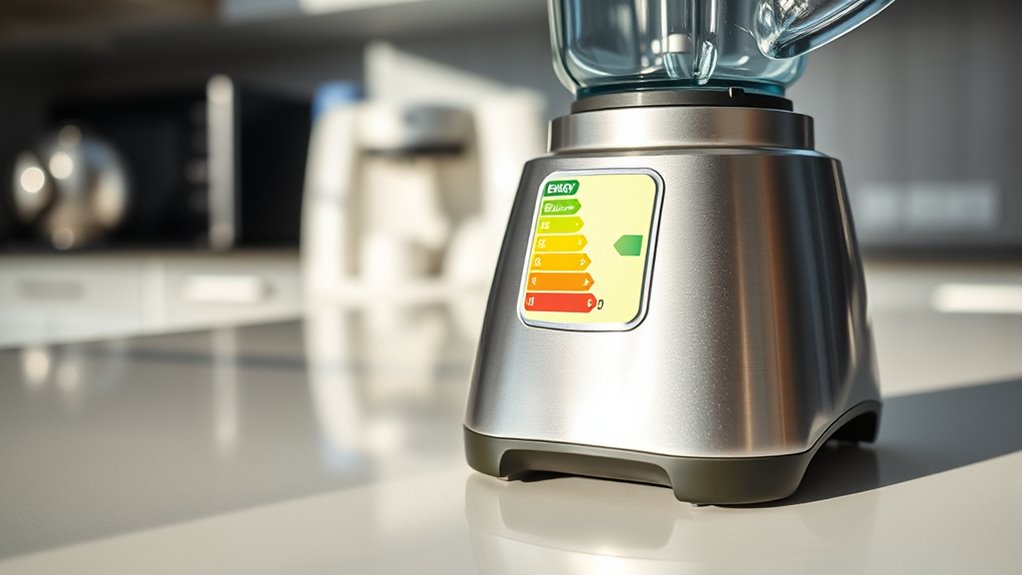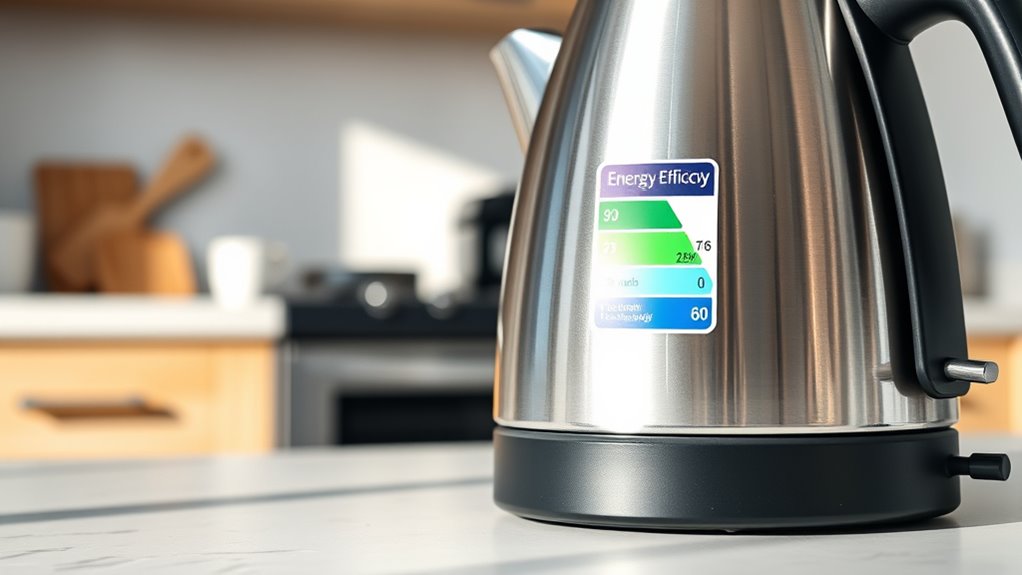Energy-efficiency labels on small appliances help you compare how much electricity each model uses and understand their environmental impact. They typically display a star rating or a letter scale, with higher scores meaning better performance, along with estimated yearly energy consumption and costs. These labels are based on standards set by regulations, ensuring transparency and helping you choose appliances that save money and reduce your carbon footprint. Keep exploring to learn how to interpret these labels effectively.
Key Takeaways
- Energy labels indicate appliance efficiency through star ratings or similar systems, helping consumers compare models easily.
- They display annual energy consumption in kilowatt-hours (kWh), aiding in estimating operational costs.
- Labels ensure manufacturers meet regulatory standards, promoting higher efficiency and transparency in product information.
- Choosing appliances with better labels reduces energy use, lowers utility bills, and minimizes environmental impact.
- Updated standards encourage the adoption of more energy-efficient small appliances over older, less efficient models.

Have you ever wondered how to choose appliances that save you money and help the environment? When shopping for small appliances, understanding energy-efficiency labels becomes essential. These labels aren’t just stickers; they’re your guide to making smarter decisions. They reflect appliance standards, which set the minimum efficiency levels manufacturers must meet, ensuring products are more energy-conscious. By paying attention to these standards, you can avoid appliances that waste power and opt for ones that are designed to be more efficient. Additionally, labeling regulations mandate clear, consistent information on labels, making it easier for you to compare different products at a glance.
Energy-efficiency labels typically display a rating or a star system that indicates how well an appliance performs in terms of energy consumption. The higher the rating or the more stars, the more energy-efficient the appliance is. This means it uses less electricity to operate, which can considerably reduce your utility bills over time. For example, a small refrigerator with a high-efficiency label not only costs less to run but also often lasts longer because it operates within ideal energy parameters. These labels also help you identify appliances that meet or exceed existing standards, giving you confidence that you’re choosing products aligned with current environmental goals.
When examining these labels, look for specific information, such as energy consumption in kilowatt-hours (kWh) per year, and compare this data across different models. Some labels include additional details like estimated annual cost, which can help you gauge how much you’ll spend on electricity annually. Keep in mind that appliance standards evolve, and regulations are updated periodically to improve efficiency requirements. This means newer models often surpass older ones in energy performance, so choosing appliances with the latest labels can make a notable difference. Understanding how appliance standards are established and enforced can further help you select products that meet high efficiency criteria.
Manufacturers are required to adhere to labeling regulations that ensure the information provided is accurate and easy to understand. This transparency allows you to make informed choices without having to decipher complicated technical specifications. By paying close attention to these labels, you’re not only saving money but also contributing to environmental conservation. Choosing appliances that meet or exceed appliance standards and comply with labeling regulations means supporting products that are designed to be energy-efficient, reducing your carbon footprint and helping to combat climate change.
Frequently Asked Questions
How Often Do Energy-Efficiency Labels Get Updated?
Energy-efficiency labels typically get updated every few years, but the exact label update frequency varies by region. You should check regional label variations, as some areas update labels more frequently to reflect new standards or improvements. Staying informed about these updates helps you make better choices, ensuring your small appliances are energy-efficient and compliant with current regulations. Keep an eye on official regional websites for the latest label updates.
Do Labels Vary Between Countries or Regions?
Did you know that nearly 70% of consumers find it confusing to compare appliance labels across regions? Labels do vary between countries or regions due to different regional standards, which can impact your ability to judge energy efficiency accurately. This inconsistency affects label clarity and comparability, making it harder for you to make informed choices. Understanding regional standards helps you navigate label differences and select appliances that truly save energy and money.
Are Older Appliances With Labels Still Reliable Indicators?
Older appliances with labels can still be reliable indicators, but appliance age affects label accuracy. Over time, technology improves, so newer labels often reflect better efficiency standards. If your appliance is quite old, the label might not accurately represent current energy performance. To verify you’re making an informed decision, consider checking recent reviews or energy audits, especially if your appliance has been used extensively or shows signs of wear.
Can Energy Labels Influence Appliance Longevity?
Energy labels can influence appliance durability because they encourage you to choose higher-quality, energy-efficient models, which often last longer due to better build standards. While label accuracy varies, reputable labels typically reflect real performance, helping you select durable appliances. By paying attention to these labels, you promote better appliance longevity, ensuring your investment remains reliable over time and reducing the need for early replacements.
How Do I Compare Labels Across Different Appliance Types?
Imagine comparing a bright, colorful dishwasher label to a sleek, minimalist refrigerator label. You can do this easily because appliance color coding and label design consistency help you. Look for familiar symbols, star ratings, and energy consumption info across different products. This uniformity makes it simple to assess efficiency at a glance, regardless of appliance type, so you can confidently choose the most energy-efficient options for your home.
Conclusion
Once you understand energy-efficiency labels, they become your guiding compass in choosing appliances. Think of them as a map that points you toward savings and sustainability. I once watched a friend switch to an energy-efficient fridge, and within months, her energy bills dropped remarkably—like finally finding a shortcut through a crowded maze. By reading those labels, you’re not just making smarter choices; you’re steering your home toward a greener, more cost-effective future.









